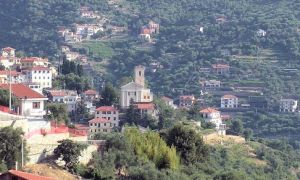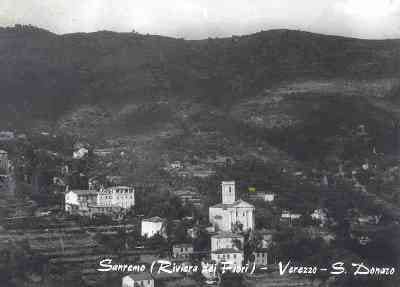True in the Parà area
 The church was built in the village of the same name in the hamlet of Verezzo in 1633 on the foundations of a small church dedicated to Saint Donato Martyr, built in 1556 to commemorate the victory of the people of Sanremo and the valley in the battle of Parà or Poggio Radino on 7th August 1543 against the Barbary pirates. The place where the new church was to be erected was the object of bitter controversy because some wanted it on the floor called La Rossa, while others wanted it lower down, near the public road on the floor called Sartori.
The church was built in the village of the same name in the hamlet of Verezzo in 1633 on the foundations of a small church dedicated to Saint Donato Martyr, built in 1556 to commemorate the victory of the people of Sanremo and the valley in the battle of Parà or Poggio Radino on 7th August 1543 against the Barbary pirates. The place where the new church was to be erected was the object of bitter controversy because some wanted it on the floor called La Rossa, while others wanted it lower down, near the public road on the floor called Sartori.
In the end it was decided to build it on the site where it still exists today, a particularly high place from where you can easily see the sea and the whole valley. In 1718 the bishop of Albenga Fornari granted that the dead should be buried in the church and the Blessed Sacrament could be worshipped, as was customary in parish churches, even though the church was still affiliated to the collegiate church of San Siro. In the same year the sacred building was enlarged with two side chapels, while the curate was given the faculty to celebrate all the functions that were held in the parish churches, with the commitment, however, to communicate to the provost of San Siro the note of the dead, the baptised and the marriages, so that the latter could record it in the parish book of Sanremo. The inhabitants of Verezzo were also obliged to satisfy the Easter precept in the church of San Siro and to pay four and a half pounds of wax for the services provided by the provost and the four canons.
In 1750 the high altar was made of marble, while in 1836 the building was further enlarged. Inside there are preserved among other things the large altarpiece Madonna with Child  Jesus and Saints, placed above the choir in the apse area, made by Bartolomeo Gazzano from Sanremo perhaps by the 1930s, vaguely influenced by the style of Domenico Fiasella and Cesare Corte, and restored by Frank Vigliani in 1994 under the direction of Bruno Ciliento and Franco Boggero; a painting of Our Lady of the Rosary and Saints, attributable to an unknown painter from western Liguria in the 18th century, placed on the back wall above the altar of the third chapel on the right side of the nave and restored by Vigliani in 1999; the painting Immaculate Virgin and Saints and the painting Madonna del Suffragio e santi, made in western Liguria during the 18th century and placed on the back wall above the altar on the left side of the nave.
Jesus and Saints, placed above the choir in the apse area, made by Bartolomeo Gazzano from Sanremo perhaps by the 1930s, vaguely influenced by the style of Domenico Fiasella and Cesare Corte, and restored by Frank Vigliani in 1994 under the direction of Bruno Ciliento and Franco Boggero; a painting of Our Lady of the Rosary and Saints, attributable to an unknown painter from western Liguria in the 18th century, placed on the back wall above the altar of the third chapel on the right side of the nave and restored by Vigliani in 1999; the painting Immaculate Virgin and Saints and the painting Madonna del Suffragio e santi, made in western Liguria during the 18th century and placed on the back wall above the altar on the left side of the nave.
Other significant works of the church are the painting of Our Lady of Sorrows and Saints, made in 1839 by L. Capoduro and placed on the back wall above the altar of the second chapel on the left side of the nave; two panels with the Mysteries of the Rosary, located respectively outside the right and left walls of the third chapel on the right side of the nave; a painting depicting a Coronation of Thorns, by an anonymous Ligurian artist of the 18th century and placed in the centre of the upper part of the intrados of the third chapel on the right side of the nave; and fourteen small canvases, made at the end of the 18th century or in the first half of the following century in Liguria, forming part of the cycle of the Way of the Cross and restored in Frank Vigliani's workshop on the occasion of the Jubilee of 2000.  Inside there is also a statue of St. Anthony of Padua, made by an unknown Ligurian artist in the 19th century and placed in front of a pilaster on the left side of the nave, and a statue of St. Donato, also sculpted in Liguria in the 19th century and placed outside the left side of the third chapel on the right side of the nave. The church also has an organ built by the firm of Nicomede Agati of Pistoia in 1865, later restored and restored to its original state by the firm Marin Parodi of Genoa. The instrument was also chosen to be played at the prestigious European Festival of Classical Music for ancient organs. The candlesticks of the high altar, decorated with inlays of precious marbles, have been restored by the artisan firm Bessone of Saluzzo.
Inside there is also a statue of St. Anthony of Padua, made by an unknown Ligurian artist in the 19th century and placed in front of a pilaster on the left side of the nave, and a statue of St. Donato, also sculpted in Liguria in the 19th century and placed outside the left side of the third chapel on the right side of the nave. The church also has an organ built by the firm of Nicomede Agati of Pistoia in 1865, later restored and restored to its original state by the firm Marin Parodi of Genoa. The instrument was also chosen to be played at the prestigious European Festival of Classical Music for ancient organs. The candlesticks of the high altar, decorated with inlays of precious marbles, have been restored by the artisan firm Bessone of Saluzzo.
In 2002 the entrance system, which has now become dilapidated, was replaced with portals and fixed system, in solid walnut wood, by the Saluzzo artisan workshop Sasia. The interior of the church was frescoed between 1913 and 1919 by the painter Arneri, then completed by a new cycle of frescoes created in 1945 by Rocco Beltrame, while the decorative apparatus of the church was completely restored by the decorator Mauro Ghisi between 1989 and 1991.
(source texts: Andrea Gandolfo; Ernesto Porri; photos: from the Web and the Group Photo Archive)




